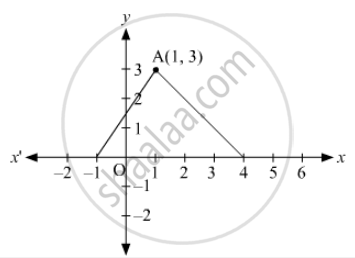Advertisements
Advertisements
प्रश्न
The base QR of a n equilateral triangle PQR lies on x-axis. The coordinates of the point Q are (-4, 0) and origin is the midpoint of the base. Find the coordinates of the points P and R.
उत्तर
Let(x ,0) be the coordinates of R. Then
`0= (-4+x)/2 ⇒ x =4`
Thus, the coordinates of R are (4,0) . Here, PQ = QR = PR and the coordinates of P lies on . y - axis Let the coordinates of P be
(0,y) . Then ,
`PQ = QR ⇒ PQ^2 = QR^2`
`⇒ (0+4)^2 +(y-0)^2 = 8^2`
`⇒ y^2 = 64-16=48`
`⇒ y = +- 4 sqrt(3)`
`"Hence, the required coordinates are " R (4,0) and P (0,4 sqrt(3) ) or P (0, -4 sqrt(3) ).`
APPEARS IN
संबंधित प्रश्न
Find the value of k, if the point P (0, 2) is equidistant from (3, k) and (k, 5).
If the point C ( - 2,3) is equidistant form the points A (3, -1) and Bx (x ,8) , find the value of x. Also, find the distance between BC
Show hat A(1,2), B(4,3),C(6,6) and D(3,5) are the vertices of a parallelogram. Show that ABCD is not rectangle.
The midpoint of the line segment joining A (2a, 4) and B (-2, 3b) is C (1, 2a+1). Find the values of a and b.
In \[∆\] ABC , the coordinates of vertex A are (0, - 1) and D (1,0) and E(0,10) respectively the mid-points of the sides AB and AC . If F is the mid-points of the side BC , find the area of \[∆\] DEF.
If A(−3, 5), B(−2, −7), C(1, −8) and D(6, 3) are the vertices of a quadrilateral ABCD, find its area.
Write the coordinates the reflections of points (3, 5) in X and Y -axes.
Find the values of x for which the distance between the point P(2, −3), and Q (x, 5) is 10.
If the distance between the points (3, 0) and (0, y) is 5 units and y is positive. then what is the value of y?
What is the distance between the points \[A\left( \sin\theta - \cos\theta, 0 \right)\] and \[B\left( 0, \sin\theta + \cos\theta \right)\] ?
Find the coordinates of the point which is equidistant from the three vertices A (\[2x, 0) O (0, 0) \text{ and } B(0, 2y) of ∆\] AOB .
The distance between the points (cos θ, 0) and (sin θ − cos θ) is
If the distance between the points (4, p) and (1, 0) is 5, then p =
The coordinates of a point on x-axis which lies on the perpendicular bisector of the line segment joining the points (7, 6) and (−3, 4) are
In Fig. 14.46, the area of ΔABC (in square units) is

If P(2, 4), Q(0, 3), R(3, 6) and S(5, y) are the vertices of a parallelogram PQRS, then the value of y is
A point both of whose coordinates are negative will lie in ______.
Abscissa of a point is positive in ______.
The point whose ordinate is 4 and which lies on y-axis is ______.
Co-ordinates of origin are ______.
